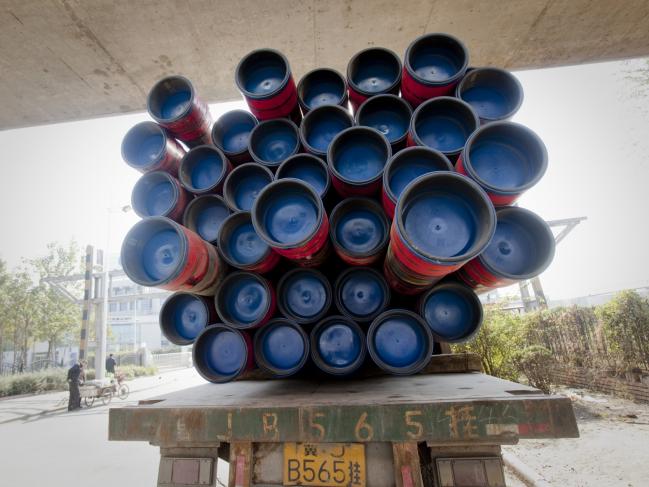(Bloomberg) -- Two of the world’s biggest oil traders gave China’s crude futures contract a go on its long-anticipated trading debut.
Commodity giants Glencore (LON:GLEN) Plc and Trafigura Group were among foreign participants as the yuan-denominated futures started on the Shanghai International Energy Exchange Monday. After an initial surge in volume that outpaced overnight transactions in global benchmark Brent crude in London, trading tapered off toward the end of the session and the contract closed at 429.9 yuan a barrel ($68.22).
In a first for Chinese commodities, the futures are open to foreign participation, which is seen as critical for the long-term success of the contract. The world’s biggest oil buyer wants to challenge the dominance of Brent and New York’s West Texas Intermediate as global benchmarks and promote the use of the yuan in international trade, a key goal for Asia’s biggest economy.
While it remains to be seen whether they’re in it for the long haul, the participation of Glencore, Trafigura and other foreign investors in the contract’s debut is a boon. In the build-up to the launch, which has been 25 years in the making, skeptics said foreign investors would be put off by China’s capital controls, regulatory risk and government intervention in the yuan.
“China has used this contract in an innovative way, to fill in the void of a voice representing buyers in Asia,” said Li Li, an analyst with Shanghai based commodities researcher ICIS-China. “With this launch, the market will pay more attention to China’s demand story.”
See here for a QuickTake on how China Is About to Shake Up the Oil Futures Market
Futures for September settlement, the most active contract, opened at 440 yuan a barrel, up from a reference price of 416 yuan. About 20,300 contracts changed hands over the course of the day, which excluded an additional 5 1/2 hours of overnight trading.
At one point, volume eclipsed trading in front-month Brent futures, which is typically lightest during the Asian day. But by 5 p.m. Shanghai time, 37,655 of those Brent contracts had changed hands. The daily average is about 285,000 for March. September Brent and WTI traded near $68.22 a barrel and $63.94, respectively, on Monday.
It wasn’t a febrile start to trading, which may be exactly what the Chinese authorities intended. They’ve frequently had to step in to quell speculation in the country’s commodities exchanges over the past few years as unprecedented trading by retail investors caused prices to swing violently.
One way of tempering the froth has been to limit physical delivery space for the oil barrels as well as set storage costs that are double the rate elsewhere. The Chinese government would rather have a slightly slower or softer launch so it doesn’t have to intervene early on in a market that’s bubbling too quickly, said Michal Meidan, an analyst at industry consultant Energy Aspects Ltd.
Glencore and Trafigura joined trading via overseas brokers, according to the Shanghai International Energy Exchange, which is known as INE. Other participants included Freepoint Commodities, BOCI Global Commodities and North Petroleum International. Among domestic companies, firms including Unipec, Chinaoil, Cnooc Ltd. and Sinochem took part. Independent refiner Shandong Huifeng Petrochemical did too.
To attract more foreign participation, China will waive income taxes for overseas individuals and institutions. About 19 foreign brokers had registered to trade the contracts as of last week, the exchange said. While the country hopes to establish a benchmark for global oil transactions, whether the Asian nation will achieve that goal has been the subject of hot debate.
A state-led market is one of the main barriers to success for the INE contract, according to Fitch Group’s BMI Research. With government policy and regulation playing a large hand in dictating consumption, production and trade, and national oil companies dominating all parts of value chain, potential participants will be wary, it said in a note on March 23.
And the yuan denomination adds another layer of risk for investors concerned about potential capital controls by Beijing and intervention in the currency market, according to BMI. Similar obstacles have kept foreign investors as bit players in the country’s giant mainland stock and bond markets. Meanwhile, crude futures that were tested in Singapore and Japan have since faded to obscurity due to low liquidity.
“It’s hard to see it becoming a major driver of oil prices in the short to medium term,” said Daniel Hynes, a senior commodities strategist at Australia & New Zealand Banking Group. “I still think there is a general reluctance from global investors to trade Chinese based contracts.”
While he’s not particularly watching it closely for the moment, ANZ’s Chinese desk is very focused on it, he said.
Then there are the bulls, such as hedge fund manager Adam Levinson, who says the start of a “petro-yuan” will be a “huge story” and increase the use of the Chinese currency in trade settlements.
